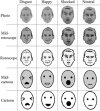Iconic faces are not real faces: enhanced emotion detection and altered neural processing as faces become more iconic
- PMID: 28180170
- PMCID: PMC5256461
- DOI: 10.1186/s41235-016-0021-8
Iconic faces are not real faces: enhanced emotion detection and altered neural processing as faces become more iconic
Abstract
Iconic representations are ubiquitous; they fill children's cartoons, add humor to newspapers, and bring emotional tone to online communication. Yet, the communicative function they serve remains unaddressed by cognitive psychology. Here, we examined the hypothesis that iconic representations communicate emotional information more efficiently than their realistic counterparts. In Experiment 1, we manipulated low-level features of emotional faces to create five sets of stimuli that ranged from photorealistic to fully iconic. Participants identified emotions on briefly presented faces. Results showed that, at short presentation times, accuracy for identifying emotion on more "cartoonized" images was enhanced. In addition, increasing contrast and decreasing featural complexity benefited accuracy. In Experiment 2, we examined an event-related potential component, the P1, which is sensitive to low-level visual stimulus features. Lower levels of contrast and complexity within schematic stimuli were also associated with lower P1 amplitudes. These findings support the hypothesis that iconic representations differ from realistic images in their ability to communicate specific information, including emotion, quickly and efficiently, and that this effect is driven by changes in low-level visual features in the stimuli.
Keywords: Emotion; Event-related potentials; Expressions; Face perception; Iconic faces; P1.
Figures





References
-
- Babbitt Kline TJ, Ghali LM, Kline DW, Brown S. Visibility distance of highway signs among young, middle-aged, and older observers: icons are better than text. Human Factors. 1990;32(5):609–619. - PubMed
LinkOut - more resources
Full Text Sources
Other Literature Sources
